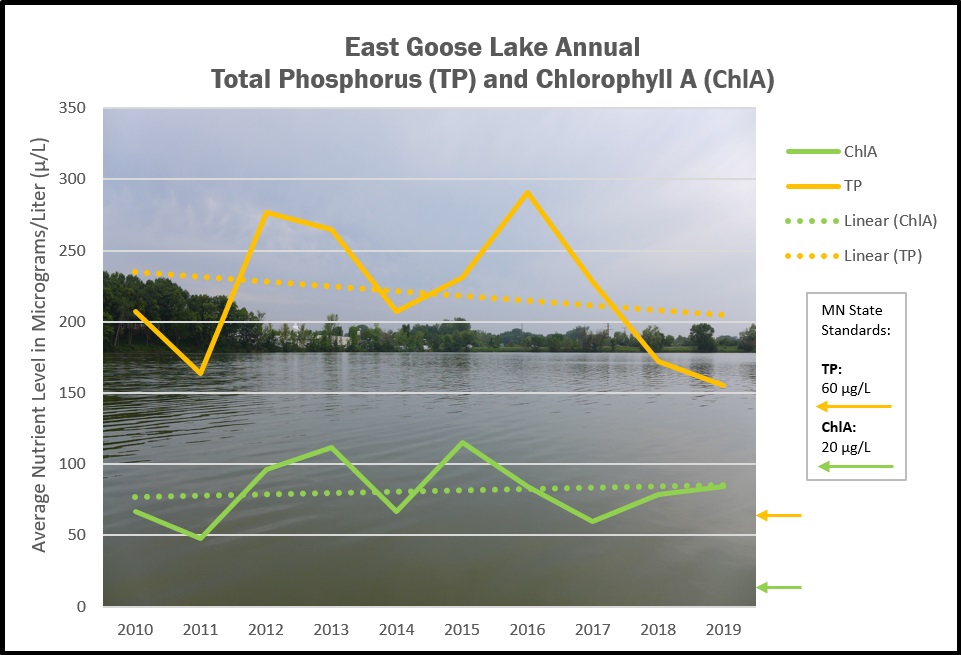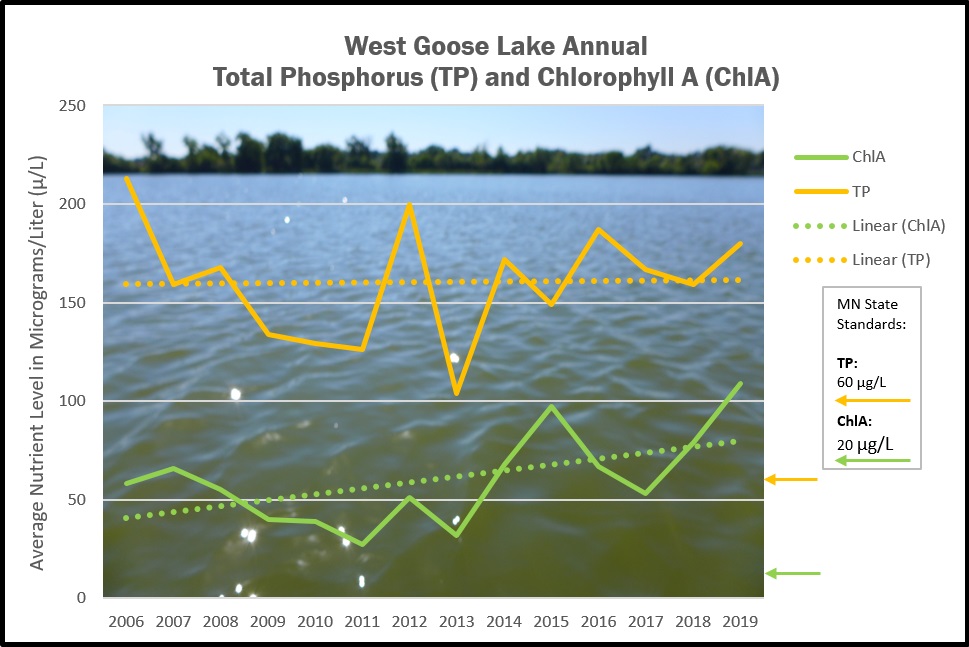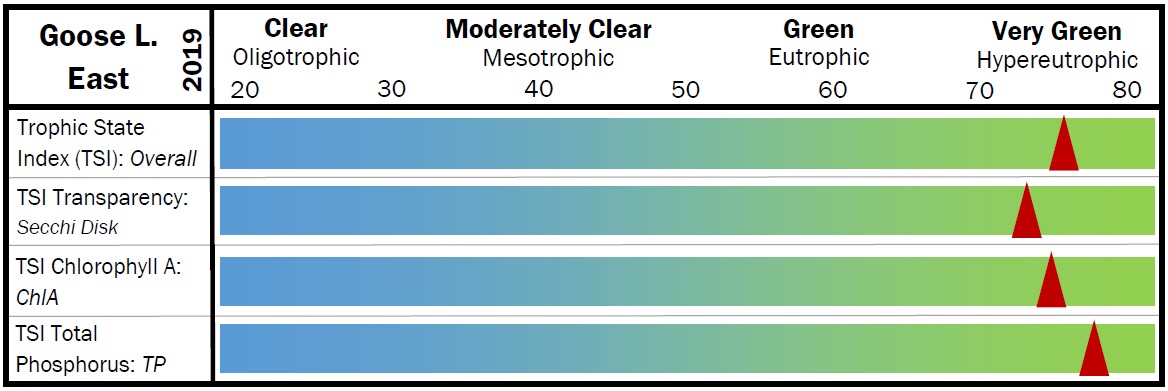Goose Lake Improvement Summary
Background:
The history and ecology of Goose Lake creates a paradox for the lake's discussion and management. VLAWMO is charged with the task to improve surface water in its watershed, and Goose Lake is one of several State-listed impaired waterbodies. To work towards water quality improvements, VLAWMO approaches each lake according to monitoring data, analysis of the lake's surrounding sub-watershed, literature reviews, and case studies from neighboring organizations. On-the ground projects, lake treatments, and community involvement are all equally important for lake management, yet sometimes there is conflict between the science and the social/recreational uses. Such is the case with Goose Lake. VLAWMO recognizes the challenges and frustrations that can result when the physical lake management strategies have converged with social and recreational uses of the lake. We hope for a shared understanding in this process, and acknowledge that a team effort between VLAWMO, the city, and the public is needed to improve Goose Lake.
To summarize Goose Lake's situation, the presentation below was given to the VLAWMO Board of Directors at the regular Board meeting on June 26, 2019. In the presentation, staff summarized current and historical issues surrounding Goose Lake with reference to scientific literature on in-lake treatment options. As seen in the graphs below, monitoring data suggests that visibility of Goose Lake (Secchi disk depth reading in meters) has trended towards improvement in recent years, yet the nutrient composition remains over the State standard. VLAWMO recognizes that lake improvements rely on the community and is thankful for the investment, interest, and discussion of everybody involved as we work toward solutions.
Why did Bald Eagle or Kohlman Lakes not see any boating restrictions with their alum treatments?
With each project, a variety of experts both in and outside of the watershed weigh in on project recommendations. Because each lake is unique, each project can look a little different depending on the conditions. In the case of Goose Lake, a boating restriction was recommended because Goose is shallower and lacks a deep pocket, such as the one seen in Kohman Lake.
Bald Eagle Lake is a deep lake with a maximum depth of 36 feet.
While a boating restriction recommendation was not well received by some members of the community, it was strictly based on technical parameters based on insights from professionals who are familiar with conducting alum projects.
What's the reason for recommending a boating restriction for Goose Lake?
A limited boating restriction was recommended to allow an alum treatment to settle and solidify on the lake bottom. Successful creation of a crust layer at the lake bottom would bind nutrients in the sediment and prevent them from re-suspending into the water column.
Why are motor boats a potential issue for alum treatments?
While motor boats are a fabulous outdoor recreation activity, they came into question with the Goose Lake alum treatment because of their potential to disturb the lake bottom. Studies show that a 50 horsepower motor boat traveling mixes the water up to 15’ deep. With Goose Lake being less than 6’ deep, it was determined that motor boats are a high risk to disturb the lake sediment and potentially affect a successful alum treatment.
Who are the agencies involved and how are they working together?
VLAWMO has gathered a variety of project partners and stakeholders concerning Goose Lake planning, all of which are open to the public. Entities involved include:
- Barr Engineering: Contracted for feasibility studies, project proposals, and project design. Firm with decades of experience conducting, monitoring, and researching best practices for alum treatments in the Twin Cities Metro.
- The MN Board of Water and Soil Resources: Distributor of grant funds, oversight organization for VLAWMO.
- The MN DNR: Input regarding water body impairments, permitting, and decision-making agency for boating restrictions.
- Ramsey County Soil and Water Conservation Division: Contracted by VLAWMO for bathymetry and aquatic vegetation studies on East and West Goose Lakes. Partner in resource protection efforts
- VLAWMO: Local watershed management organization that applied for alum treatment grant funds, coordinated past studies and projects on Goose Lake, conducts water monitoring efforts on Goose Lake, is charged with task of improving local water resources.
- The City of White Bear Lake: Goose Lake is wholly within the City of White Bear Lake. Authority for policies such as the shoreline ordinance and boating restrictions. Partner in resource protection efforts.
-
The MN Pollution Control Agency: has established water quality standards, the impaired waters list, and tracks stormwater permit holding agencies to assure compliance with requirements .
-
White Bear Ski Otters: Stakeholders and long-time recreation organization on Goose Lake. Weekly ski shows are held on West Goose Lake.
-
MN Department of Transportation: Input regarding Highway 61.
-
Public: People who live and work in the community and may have preferences about lake conditions where they live and work.
Why can’t other types of treatment be pursued for Goose Lake? What other treatment options are there?
Goose Lake has a complicated history. An impaired waters study (TMDL), 2014 approved by the MPCA and the EPA identified in-lake nutrient levels cycling between the water column as the primary source of excess nutrients. It is determined that an in-lake treatment is more effective than addressing the out-of-lake, incoming sources of nutrients. This history has been shaped by former municipal waste dumping (in the 1950s-‘60s), alteration of habitat. (indications show Goose was originally an open wetland), and many years of high nutrients from stormwater runoff draining in from an urbanizing subwatershed.
At this time, there are no other feasible treatment options for in-lake treatments besides an alum treatment. Literature and examples from around the country on alum treatments have become abundant and reliable as project guidance. Out-of-lake treatments come in many shapes and sizes, from raingardens, underground retention basins, sand-iron treatment filters, and community-driven efforts such as adopt-a-drain (adopt-a-drain.org). In the challenge of lake management, a variety of these tools are used depending on the sub-watershed (landscape surface), lake ecology, budget, lake users, and surrounding community. For a lake like Goose Lake with internal nutrient issues, other options are far more expensive and cannot treat the nutrients that are already buried in the sediment in the lake.
What's wrong with Goose Lake?
Goose Lake is listed as an impaired waterbody by the MN DNR. Over ten years of water quality data shows that East and West Goose lake exceed the State standard for phosphorus and chlorophyll-A levels.
What's the timeline for the proposed alum treatment?
If the Clean Water Fund proposal to BWSR is funded, an alum treatment would be applied in two installments to maintain a safe pH range in the lake. The two installments together are the calculated dose needed to treat Goose Lake. Those installments would be separated by a year to allow the lake to acclimate. VLAWMO has proposed a fall first installment of an alum treatment in 2020. That would be followed by a year with no additional alum added during 2021 and a spring final alum installment in 2022.
Would an alum treatment lead to more aquatic vegetation?
In short, yes. A shallow lake exists in one of two states: algae-dominated with little to no aquatic vegetation, or plant-dominated, with clear water. One consequence of clear water is that sunlight is able to penetrate the lake surface and foster plant growth. Nutrients in a clear water state are held within the aquatic vegetation, while an algae-dominated state holds nutrients in the water column for algae to use.
Are there more bullhead in Goose Lake now than three years ago?
Yes. Bullhead removal was done by VLAWMO in the past as part of preparation for the alum treatment. Lakes dominated by algae are bad for fish. Predator fish are less likely to survive and only hardy fish such as bullhead are likely to remain. Algae that proliferate in polluted lakes are not nutritious, do not provide habitat for fish, and, when they die and decay in the lake, their decomposition uses up oxygen that more sensitive fish need to survive. There is evidence of recent fish kills in Goose Lake and very limited fish diversity. Individual fish are also much smaller than would be expected in a healthy lake, showing evidence that they are food limited.
Is Goose Lake improving?
East and West Goose water quality data show a slight improvement in phosphorous (TP) and chlorophyll A (ChlA) from 2016-2018. In 2019 however, West Goose TP and ChlA levels rose to surpass East Goose. All measurements are still consistently above the State standard. VLAWMO estimates that the 2016-2018 improvement was due to a few wet years with above-average rainfall, diluting the nutrient levels. High nutrient levels remain in the sediment of both lakes.
Annual Lake Data


Visit our reports page for more lake data in our annual monitoring reports, or visit the East Goose Lake web page for more studies and reports specific to Goose Lake.
TSI Tables
A Trophic State Index (TSI) is an additional calculation made from the annual lake data. The TSI scale is used in water management to classify lakes on a consistent scale according to their nutrient content.


Addressing Historical Influence: In-Lake Focus
Historical wastewater discharge from the City of White Bear Lake and wetland alteration are major factors in Goose Lake's impairment. Unfortunately, these policies and decisions from the 1930s-1960s have left negative impacts on the lake that linger to this day. Before development occurred, the soils stored nutrients as water moved downstream through what is now known as Lambert Creek, which is also an impaired waterbody. As urban development occurred, road construction, and increased stormwater runoff converted a wetland into a lake with already nutrient-rich soil. This was compounded by decades of untreated wastewater discharge from the city, which further increased the nutrient and algae levels in the lake.
Goose Lake is now a shallow lake stuck in an algae-dominated state. Aquatic vegetation and the support it would provide to the lake and water quality is sparse to nonexistent. This makes the lake challenging to improve. An alum treatment is one of the tools available for treating in-lake nutrient loads. This strategy requires a time period of low sediment disturbance to lock phosphorus into the sediment and keep it from returning into the water. Unlike the alum treatment completed in nearby Bald Eagle Lake, Goose Lake's shallow depth causes boat traffic to be problematic for alum treatments. Studies show that in-lake treatment is the most effective tool for Goose Lake's unique needs. As a Water Management Organization, VLAWMO provides data, studies, and recommendations to the city and the public, and it is up to democratic process to guide policy decisions.
Addressing the Surrounding Watershed: Out-of-Lake Focus
REDUCE THE NUTRIENTS GOING INTO THE LAKE
Best Management Projects (BMPs) such as raingardens, bioswales, sand-iron filters, and underground retention basins collect and treat stormwater before it enters Goose Lake. This helps reduce incoming sediment and nutrients such as phosphorus, which encourages a cleaner, healthier lake. This BMP at Central Middle School in White Bear Lake is an example of a retention basin that was planted as a bioswale above it. VLAWMO and the City of White Bear Lake are seeking invested property owners and managers to partner with for these projects. VLAWMO's cost-share program provides various levels of grant funding for such projects. Visit our grants webpage to learn more. A VLAWMO staff member is available to visit your property for a free, on-site consultation. Click here to view a map of current and recommended BMP locations produced by Barr Engineering.
ADOPT-A-DRAIN
Every curb and stormdrain is lakefront property. Adopting a stormdrain is an easy and effective way for homeowners to help improve Goose Lake. Dozens of residents are already contributing by cleaning leaves, grass clippings, trash, sediment, salt, and other debris out of their nearby drains. Every bit adds up! Visit Adopt-a-Drain.org to get started. Once there, find your nearest stormdrain, give it a clever name, and log your results to help tally the impact of the community effort. VLAWMO and the City of White Bear Lake have teamed up to provide free welcome packets and yard signs (pictured below) delivered to residents and businesses who sign-up in the Goose Lake subwatershed.
RE-ESTABLISHING NATIVE PLANT SPECIES, PARTICULARLY ALONG SHORELINES
Native plants are a great option for retaining moisture in the soil and reducing runoff from the landscape. Their deep roots provide valuable structure for soil and nutrients, particularly when planted along a shoreline. The Birch Lake shoreline restoration is an example of a shoreline protection effort made possible by collaboration between citizens, the City of White Bear Lake, and VLAWMO.
Native plants are also a benefit to pollinators such as bees and butterflies. According to the U.S. Fish and Wildlife Service, the Goose Lake subwatershed is within a high potential zone for the endangered Rusty-patched Bumblebee. As Minnesota's new State bee, this provides an exciting opportunity for the White Bear Lake community to contribute to this conservation effort by promoting the use of native plants in parks and yards. Click here to view the USFWS Rusty-patched Bumblebee map.
CONTROLLING INVASIVE CURLY-LEAF PONDWEED
Curly-leaf Pondweed is an aquatic invasive plant from Eurasia, Africa, and Australia. It begins its life cycle early in the year, when ice is still present on the lake. Die-off occurs in late summer. When the plants die, nutrients are released into the water column. Combined with high levels of nutrients already in the lake, this makes for a recipe for strong algae blooms. VLAWMO has started an effort to reintroduce native aquatic vegetation in coordination with the MN DNR.

PRACTICE WATER-FRIENDLY LAWN CARE
Take a moment to plan ahead and develop water-friendly yard habits.
 Photo: Clean Water MN
Photo: Clean Water MN
Examples include:
- Mowing at a height of 3" minimum to encourage deep root growth, moisture retention, and better topsoil coverage.
- If you must fertilize, do so in the fall when grass is preparing for winter. Grass will absorb more in this time of need opposed to spring and summer application. Leave grass clippings on the lawn for a free dose of fertilizer each time you mow.
- Aerate in the fall every few years to boost root depth and infiltrate more water into the soil.
- Avoid weed-and-feed mixtures. Combined applications are often more for convenience than what the yard needs. VLAWMO recommends getting a soil test done to apply according to need. Weeding by hand or allowing a few dandelions is a great way to reduce the risk of herbicide runoff into Goose Lake.
- Keep grass clippings out of the street - mow strategically so that the clippings blow up onto the lawn. Sweep clippings if they do fall into the street.
- Try a bee lawn or an alternative low-mow fescue to reduce maintenance and improve watershed impact.
- Visit our Water Stewardship at Home webpage for more info and tips.
Resources:
- October 22, 2019 presentation: PDF download
- June 26, 2019 discussion: Meeting Follow-up
- Goose Lake Alum & Science Review: PowerPoint presentation, Powerpoint Notes
- Goose Lake Data: Total phosphorus, Chlorophyll A, Secchi disk
- Goose Lake Data: TP and MN State standard
- East and West Goose + Oak Knoll Pond: 2018 Feasibility Study
- Reference video concerning shallow lakes: Getting to know Shallow Lakes
- Visit the East Goose Lake web page for more data and Reports
- Visit the Board Meeting Information web page for meeting agendas and minutes
Recent Posts
Neighborhood Spotlight: Carol
Neighborhood Spotlight: Joe
VLAWMO Recruiting MN Water Stewards
Neighborhood Spotlight: Ingrid
Spring Yard Care for Water Conservation
Tags
- Adopt-a-Drain
- annual report
- awards
- Birch Lake
- carp
- chain of lakes
- Charley Lake
- citizen science
- climate
- Community Blue
- Cost-share
- education
- Faces of Wetlands
- fish
- floating island wetland
- flowage
- GIS
- Goose Lake
- grants
- groundwater
- invasive species
- irrigation
- lake management
- Lakes
- Lambert Creek
- Lawn Care
- lawncare
- monitoring
- native plants
- Neighborhood Spotlight
- pollinators
- projects
- Raingardens
- remote cameras
- Rice Lake
- Saint Paul Regional Water Service
- salt
- Shoreline Restoration
- Spring
- Staff
- stewardship
- stormwater
- Stream
- students
- Sucker Lake
More news
-
2025
-
2024
-
November
-
September
-
August
-
June
-
April
-
March
-
February
-
-
2023
-
December
-
October
-
September
-
August
-
June
-
May
-
April
-
March
-
February
-
January
-
-
2022
-
October
-
September
-
August
-
June
-
April
-
March
-
January
-
-
2021
-
December
-
November
-
October
-
September
-
August
-
June
-
May
-
April
-
March
-
February
-
January
-
-
2020
-
December
-
November
-
October
-
September
-
August
-
July
-
May
-
April
-
March
-
-
2019
-
November
-
October
-
September
-
June
-
May
-
March
-
January
-
-
2018
-
November
-
October
-
September
-
June
-
May
-
March
-
February
-
January
-
-
2017
-
November
-
October
-
May
-
February
-
January
-
-
2016
-
November
-
October
-
June
-
May
-
April
-
March
-
January
-
-
2015
-
November
-
October
-
August
-
July
-
June
-
-
2014
-
December
-
September
-
August
-
July
-
 Contact us
Contact us
Phone: (651) 204-6070
Fax: (651) 204-6173
Email: office@vlawmo.org


